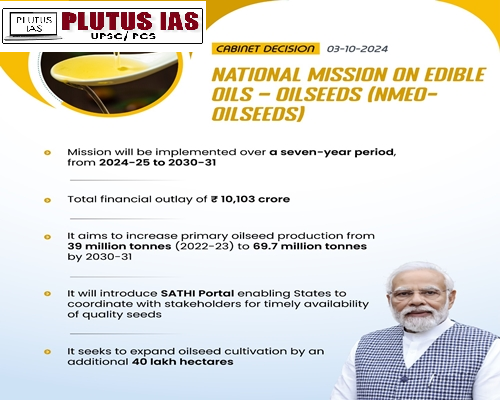Why It Is News
The government’s approval of the ₹10,103 Crore National Mission on Edible Oils and Oilseeds (NMEO-Oilseeds) is significant for several reasons. It marks a concerted effort to enhance domestic oilseed production, addressing India’s long-standing reliance on edible oil imports. This initiative comes at a crucial time when global supply chain disruptions and rising prices have highlighted the vulnerability of India’s food security. The mission aims to create a more resilient agricultural economy while improving farmers’ livelihoods and contributing to national self-sufficiency.

Reasons for Enactment:
1. High Import Dependency:India imports about 60% of its edible oil needs, primarily from countries like Indonesia and Malaysia. This dependency poses economic risks, especially with fluctuating global prices.
2. Rising Domestic Demand: With projections suggesting that India’s edible oil consumption could reach approximately 35 million metric tonnes by 2030, there is an urgent need to enhance domestic production.
3. Support for Farmers:The mission aims to improve farmers’ incomes by encouraging the cultivation of oilseeds, thereby providing them with a stable source of income in an often volatile agricultural market.
4. Environmental Sustainability:The focus on sustainable practices will help conserve water resources, improve soil health, and optimize the use of fallow land, contributing to broader environmental goals.
5. Technological Advancements: By utilizing cutting-edge technologies like genome editing, the mission seeks to improve crop yields and resilience against pests and climate change.
Key Features:
1.Financial Outlay: The mission is backed by a significant allocation of ₹10,103 Crore for the period of 2024-25 to 2030-31.
2.Targeted Oilseed Crops: Emphasis on increasing the production of key crops such as rapeseed mustard, groundnut, soybean, sunflower, and sesamum.
3.Secondary Source Utilization:The initiative will enhance the extraction efficiency from secondary sources, including cottonseed, rice bran, and tree-butter oils.
Production Goals: The mission aims to increase primary oilseed production from 39 million metric tonnes in 2022-23 to 69.7 million metric tonnes by 2030-31.
Collaborative Synergy:When combined with the National Mission on Oil Palm (NMEO-OP), the initiative targets an overall domestic edible oil production of 25.45 million metric tonnes, meeting about 72% of projected requirements.
Objectives and Targets of National Mission on Edible Oils:
1. Expansion of Oil Palm Cultivation
Current Status: 3.5 lakh hectares (as of 2019-20)
Target by 2025-26: Increase the area to 10 lakh hectares.
Additional Area:6.50 lakh hectares
General States: 3.22 lakh hectares
North Eastern States: 3.28 lakh hectares
2. Production Goals
Current Production: 0.27 lakh tonnes (as of 2019-20)
Target by 2025-26:Increase crude palm oil production to 11.20 lakh tonnes.
Targeted Fresh Fruit Bunch (FFB) Production:66.00 lakh tonnes.
3. Consumer Awareness
Objective:Enhance consumer awareness to maintain a consumption level of 19.00 kg/person/annum until 2025-26.v
Significance:
1. Economic Stability: Reducing import dependence will conserve foreign exchange and stabilize the economy against global price volatility.
2. Food Security: By increasing domestic production, the mission aims to secure a reliable supply of edible oils, enhancing food security for the population.
3. Rural Empowerment:The mission is expected to generate rural employment opportunities and uplift farmers’ livelihoods.
4. Sustainable Agriculture: The focus on low water usage and improved soil health promotes sustainable farming practices, aligning with global environmental goals.
5. Technological Innovation: The incorporation of modern technologies will boost productivity and ensure the resilience of oilseed farming.
6. Value Addition: Increased domestic production can lead to the establishment of processing units, enhancing the value chain and creating more job opportunities in rural areas.
7. Reduction in Price Fluctuations: A stable domestic supply of edible oils can help mitigate price fluctuations, benefiting both consumers and producers.
Challenges:
1. Resource Constraints: Limited availability of arable land and water resources may impede large-scale oilseed cultivation.
2. Farmer Resistance: Some farmers may be reluctant to shift from traditional crops to oilseeds, necessitating education and incentives.
3. Market Fluctuations: Domestic prices can still be influenced by global market trends, which could affect profitability for farmers.
4. Infrastructure Issues: Inadequate infrastructure for processing and storage may limit the mission’s overall effectiveness.
5. Coordination Complexity: Ensuring effective coordination among various government departments and stakeholders is essential for successful implementation.
6. Biodiversity Disruption:Expanding oil palm cultivation may lead to habitat loss and disruption of local ecosystems, raising environmental concerns.
7. Food Security Concerns: Prioritizing oilseed cultivation could reduce the area under food crops, potentially impacting food security for local populations.
Way Forward:
1. Invest in Research: Increase funding for agricultural research focused on developing high-yield and climate-resilient oilseed varieties.
2. Farmer Training Programs: Implement comprehensive training initiatives to educate farmers about modern cultivation techniques and sustainable practices.
3. Improve Infrastructure: Develop and upgrade storage and processing facilities to minimize post-harvest losses and enhance supply chain efficiency.
4. Policy Support: Formulate supportive policies that encourage oilseed cultivation and provide financial incentives for farmers.
5. Monitoring Mechanisms:Establish a robust monitoring and evaluation framework to assess progress and adapt strategies as needed
Conclusion:
The National Mission on Edible Oils and Oilseeds is a crucial initiative aimed at transforming India’s agricultural landscape by enhancing self-reliance in oilseed production. With significant financial backing and a clear focus on sustainability and technological innovation, this mission has the potential to reduce import dependency, improve farmer incomes, and promote environmental sustainability. However, overcoming challenges such as resource constraints and market volatility will require concerted efforts from all stakeholders. If successfully implemented, the NMEO-Oilseeds could significantly contribute to India’s economic stability and food security by 2030.







No Comments